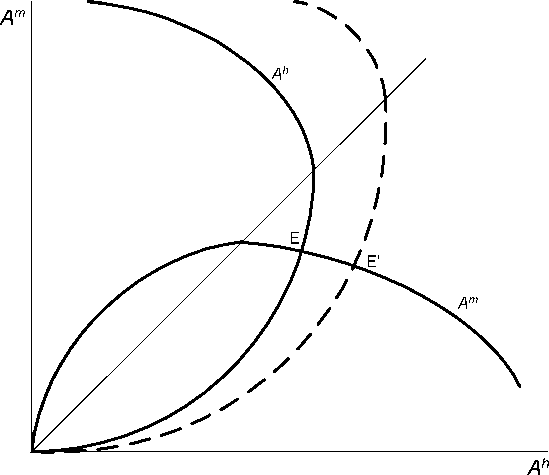10

Figure 4. Joint Movements in Activism
the number of their own activists. An increase in radicalism does not necessarily translate into
an escalation of conflict.
Propositions such as this have potentially interesting implications. By studying the changing
patterns of conflict in societies we may be able to deduce the identity of an instigating party. To
be sure, such an assertion needs to be treated with due care. The model studied here neglects
psychological reactions to aggression, which may have the effect of altering the very parameters
that defines a party’s equilibrium response function. It remains to be seen whether this sort of
analyis can be usefully extended to more general and realistic situations.
There are also implications for the effects of group polarization on conflictual outcomes. Each
group has a distribution of possible characteristics: wealth, population and radicalism among
them. It is, of course, hard to say ex ante which bundle of characteristics is inherently the more
conflictual. One convenient shorthand is given by the nature of the equilibrium itself: the “less
conflictual” group is the one that contributes, for one reason or another, the fewer activists in
equilibrium. The proposition then states that an “aggressive change” in the characteristics of
that group provokes an aggressive response in its opponent. In this sense, a polarizing change
provokes a more aggressive stance in the opponent.
The proposition states that the same is also true if the group that is more conflictual to start
with experiences a change that makes it less aggressive. That, too, provokes an aggressive re-
sponse from the opponent.
So far, we have been describing the two contrasting situations in terms of the generated pat-
terns of activism. One might ask if implications can be drawn for the overall level of conflict. The
problem, of course, is that the “overall level” of conflict is hard to define. Consider a situation in
which the less conflictual group increases its aggression. As discussed already, this provokes an
aggressive reaction and “overall conflict” defined in any reasonable way must rise. This process
continues until the two equilibrium response functions cross exactly at the 450 line. Now further
More intriguing information
1. Modeling industrial location decisions in U.S. counties2. ALTERNATIVE TRADE POLICIES
3. The name is absent
4. The name is absent
5. The Values and Character Dispositions of 14-16 Year Olds in the Hodge Hill Constituency
6. The name is absent
7. PERFORMANCE PREMISES FOR HUMAN RESOURCES FROM PUBLIC HEALTH ORGANIZATIONS IN ROMANIA
8. EMU's Decentralized System of Fiscal Policy
9. The name is absent
10. The name is absent